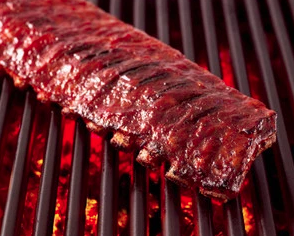Paula And Sandy's Real Barbecue
The History Of Barbecue

Roasting meat over a fire has been around since ancient times. Smoked foods also keep longer and as with drying and salting were used for preservation before the days of refrigeration. Spits and five-pronged forks used at outdoor feasts in ancient Greece are mentioned in both the Iliad and The Odyssey. In India, food has been cooked over coals in ceramic urns called tandoors for centuries, and in Japan the Kamado, another ceramic cooking urn has been around for about 3000 years.
Merely throwing meat on a grill is not a traditional barbecue. The real thing is cooked over indirect heat, usually a wood fire, for up to eighteen hours. The resulting flavor is a combination of smoke, meat juices, fat and whatever spices or rub have been added.
The American Barbecue

It was the Spanish Empire’s exploration of the New World that lay the foundation for the modern American barbecue. They arrived with cattle, pigs, sheep and goats that they spit roast with local ingredients including tomatoes, potatoes, corn, chile peppers, chocolate, and more. These are the basic ingredients of contemporary barbecuing. In 1492 Christopher Columbus, on his first voyage to Haiti, ate a roasted iguana and us recorded as stating "the meat is white and tastes like chicken."
The first documented record of the word barbecue was in 1526 with the word barbacoa, the Spanish interpretation of a word used by Taino Indians in the Caribbean who were observed slow-cooking meat over a wooden platform.
Modern history

By the nineteenth century, the culinary technique was well established in the American South, and because pigs were prevalent in the region, pork became the primary meat at barbecues. Corn bread emerged as the most popular side dish. Barbecue became popular for large gatherings as they allowed an abundance of food to be cooked at once.
Because barbecue doesn’t require expensive cuts of meat it became a dietary staple for impoverished Southern blacks, who frequently paired it with vegetables like fried okra and sweet potatoes. The first half of the 20th century saw a mass migration of African Americans from the rural South to Northern cities, and as they moved, they took their recipes with them.
Regional variation
Barbecue varies by region, with the four main styles named after their place of origin. Memphis is renowned for pulled pork-shoulder doused in sweet tomato-based sauce. North Carolina smokes the whole hog in a vinegar-based sauce. Kansas City natives prefers ribs cooked in a dry rub, and Texans in the west prefer beef and eastern residents pulled-pork. Locals defend their region’s cooking style with fierce loyalty. By the 1950s, black-owned barbecue joints had sprouted in nearly every city in America.
Other countries barbecue in their own style. Korean barbecue features thin slices of beef or pork cooked and served with rice. Argentina has asado, or marinade-free meat cooked in a smokeless pit.
